Guadalupe National Park
The Sand Dunes
Text and Photos by George Oxford Miller
A snow field in West Texas? I don't think so. Yet, from eight thousand seven hundred and forty nine feet atop Guadalupe Peak, the highest point in Texas, the crystalline mass on the desert floor below doesn't fit the typical desert scene. The anomalous finger of white cuts through a landscape of red, brown and yellowish sand like a lost glacier.
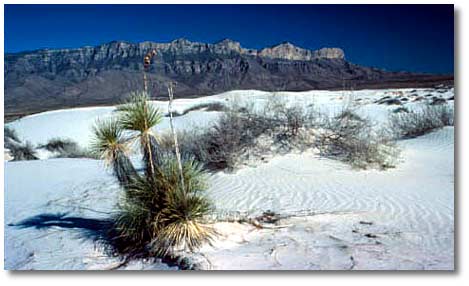
One of Texas’ most curious natural wonders lies hidden against the towering escarpment of the Guadalupe Mountains. Winds whip across the surrounding salt flats and pick up crystals of snow-white gypsum like a broom sweeping a dusty floor. When the breezes hit the mile-high wall of the mountains, they deflect upward and dump their load. Giant white dunes of the jettisoned sand rise dramatically from the desert floor, similar, though smaller in scale, to White Sands in neighboring New Mexico.
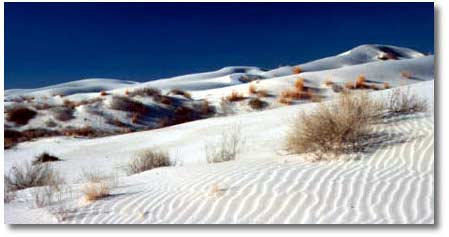
After my aerial view of the anomalous formation, I want to see it from close up. Once you had to drive through private ranch land and follow the rule of the range to close gates behind you. The Nature Conservancy first preserved a section of the dunes, now most are included in Guadalupe National Park. I drive outside the park to Del City, then head back toward the towering range. A two and a half-mile walk takes me to the unusual phenomenon.
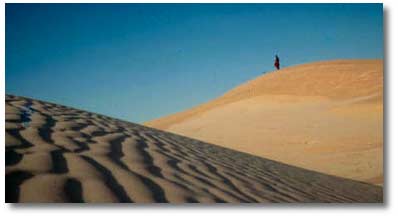
The reddish-brown sand ends abruptly at the sloping base of the one hundred-foot-high white dunes. To the west, barren salt flats stretch toward El Paso. East of and above the dunes, the limestone cliffs of El Capitan and Guadalupe Peak glow golden in the evening sun. Dark shadows of half-buried yuccas, their length extended by the afternoon sun, creep down the bleached slopes.
I trudge up the crumbling slope to the ridge top of the first dune. Before me stretches five thousand acres of undulating snowy sand, a scene more reminiscent of Alaska than the Chihuahuan Desert. Petrified snow, I think.
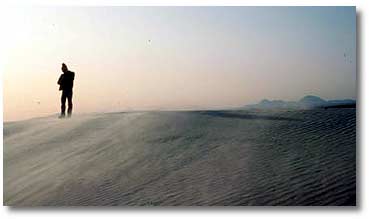
I strike out across the barren ridges and valleys of gypsum. The arid zone presents an inhospitable habitat, but the myriad tracks indicate I am not alone. Snakes and lizards leave tell-tell signs in the shifting grains. The sidewinding trail of a western diamondback rattlesnake zigzags across the highest dunes. A rare variety of lesser earless lizard has carved out a niche here also. Its grayish-white color matches the sand.
The multitude of tracks crisscrossing the dunes suggests a rampant night life. In the cool of the evening and under the protection of darkness, both large and small mammals emerge from their dens to search for food. The plants of the desert support a large population of kangaroo rats and pocket mice. Kit foxes, coyotes and snakes feast on the rodents. The tracks of hungry predators follow the endless trails of mice prints. Confused marks of jumps, sharp turns and quick stops give no hint of the outcome of the struggle for survival.
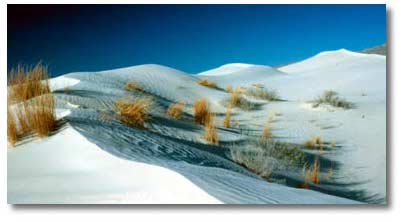
Plant life stabilizes much of the five thousand acres of white sand, but the wind still pushes the dunes across the surrounding reddish sand. The shifting grains wage a constant battle against the tenacious plants. The roots dig in and slow, or temporally stop, its movement. But driven by the wind, the roving sand emerges the ultimate victor. Gnarled stems of salt bush lie scattered across the sand like the bleached bones of some unfortunate animal.
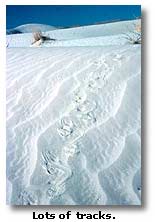 Annual plants ride the dunes like surfers. They bloom and scatter their seeds before being inundated by the frothy waves of sand. The plants represent some of the major curiosities of the area. The gypsum sand and the surrounding salt flats create an ecologically unique area. Only plants specialized for the infertile soil and the hot, arid climate can survive. So far, eight plants on the gypsum dunes are classified as very rare. Twenty five are endemic; they occur nowhere else in the world.
Annual plants ride the dunes like surfers. They bloom and scatter their seeds before being inundated by the frothy waves of sand. The plants represent some of the major curiosities of the area. The gypsum sand and the surrounding salt flats create an ecologically unique area. Only plants specialized for the infertile soil and the hot, arid climate can survive. So far, eight plants on the gypsum dunes are classified as very rare. Twenty five are endemic; they occur nowhere else in the world.
Biology survey teams from the University of Texas and Texas Tech University discovered two plant species that had never before been described. A broom-like shrub, Lepidospartum burgesii, occurs on the periphery of the white sand, and a member of the sunflower family in the genus Ericameria grows in the stabilized dunes. Beside the rare plants, the dunes also host unusual combinations of plants.
Two million years ago, a series of shallow seas covered much of the area west of the Guadalupe Mountains. Sediments and dissolved minerals washed into the seas from the mountain slopes. The water evaporated, leaving behind a thick layer of minerals, primarily sodium chloride, or table salt, and hydrous calcium sulfate, or gypsum.
A number of varieties of gypsum formed from the evaporating shallow seas that once covered much of the West. Clear, glassy selenite crystals create prisms, rosettes and flat sheets. Fibrous gypsum occurs as slender fibers, and rock gypsum forms massive granular deposits. Alabaster is a fine-grained, translucent variety favored by sculptors.
Today, salt flats cover a layer of gypsum clay deposited in the ancient sea beds. Rain soaks in and dissolves the gypsum, then evaporates and leaves it deposited on the surface. Wind carries the crystalline gypsum sand, mixed with quartz and feldspar crystals, and spreads them over the red quartz sand dunes that once covered the prehistoric ocean shores.
Exploring in the dunes, I see what looks like a miniature city exposed along one of the eroded slopes. I stoop to investigate and find tubular structures from gypsum crystals that solidified around roots. The roots rotted away long ago leaving the fanciful shapes.
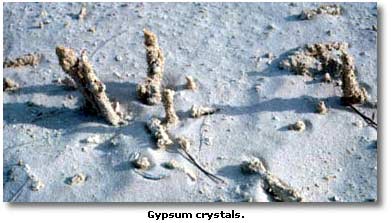
With Disney-shaped rocks, Technicolor sands, and unusual plants, deserts have always stimulated the imagination. The bizarre white dunes at the base of the Guadalupe Mountains add one more charm to the majesty of this stark landscape.
For a map to the dunes, stop in the national park visitor center in Pine Springs, Texas, on U.S. Highway 62/180. Access is through Dell City and requires a two and one half mile walk from the end of the road. For information on Guadalupe National Park, click link below.
Related Pages
Guadalupe National Park
Related DesertUSA Pages
- How to Turn Your Smartphone into a Survival Tool
- 26 Tips for Surviving in the Desert
- Death by GPS
- 7 Smartphone Apps to Improve Your Camping Experience
- Maps Parks and More
- Desert Survival Skills
- How to Keep Ice Cold in the Desert
- Desert Rocks, Minerals & Geology Index
- Preparing an Emergency Survival Kit
Share this page on Facebook:
The Desert Environment
The North American Deserts
Desert Geological Terms



